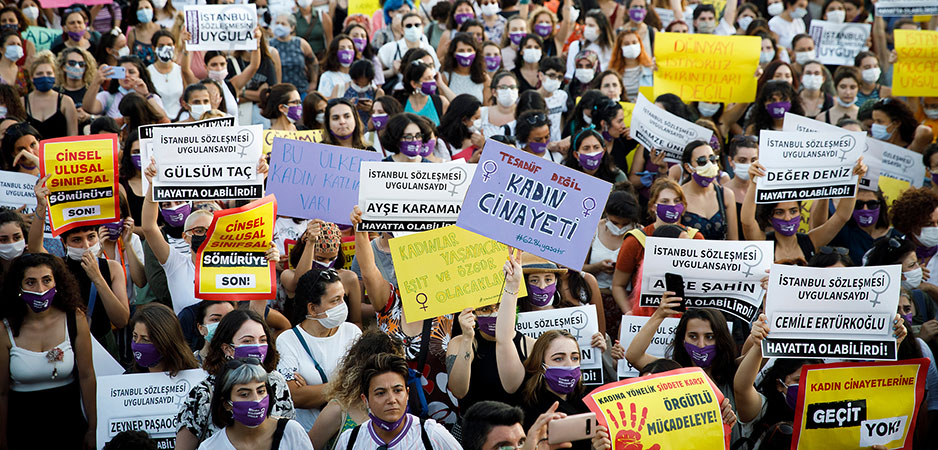Last year, a report by the United Nations Office on Drugs and Crime estimated that of the 87,000 women who were intentionally killed in 2017 around the world, more than half — 50,000 — were murdered by intimate partners or family members, mostly in their homes. According to official and unofficial records, an average of seven women are killed every day in the Republic of South Africa, six in Mexico, three in Brazil, while in Turkey, Germany and France, a woman is murdered every three days by an intimate partner and every six days in Spain. Unfortunately, global domestic violence and femicide rates have gone significantly up since the introduction of the COVID-19 lockdown measures.
Around the World, Femicide Is on the Rise
It is astonishing that every day that goes by, women are killed the world over in the ordinariness of daily life — not in times of war, internal conflicts or gang violence, but by the people closest to them. These women are not mere statistical data: When you know their names, once you have seen their photographs, watched their videos or read their stories, the individual tragedies become haunting nightmares.
Drivers of Violence
To put matters in context, it is important to point out that violence is widespread around the world, especially in Latin America, Africa and the Middle East. For example, in Mexico, with a population of 130 million, 3,752 women were killed in 2018 compared to 32,765 men. There is a similar picture in Brazil, with a population of 210 million. A total of 41,634 murders were committed in 2019, of which 1,314 were women and nearly 40,000 were men. In South Africa, with a population of 60 million, another country where violence is common, 20,336 murders were committed in 2017; of these, 2,930 of the victims were women and 16,421 were adult males.
It should be noted that the countries with the highest total number of murders are also the ones with the highest rates of income inequality in the world. According to the Gini coefficient that measures income inequality, South Africa is in first place, with a score of 63.1, while Brazil is at high at the top with 54.7 and Mexico with 47.2. These can well be understood as meaningless, technical statistics. However, they describe the current social inequalities that translate into unemployment, poverty, hunger, homelessness — drivers of crime and, inevitably, of violence.
Due to social inequality, almost all buildings in rich districts in Brazil are fenced up and equipped with cameras. Because of this distorted social structure, the number of private security guards employed in the wealthy districts of South Africa far exceeds the number of police in the country. Again, due to social inequality, the drug trade has been one of Mexico’s main problems for decades and is one of the main causes of violence.
Violence is an inequality-driven social problem and must inevitably be addressed together with other social phenomena. However, the experiences of women who continue to be killed every day should be described as a distinct social problem that requires a unique approach and understanding. First, femicide is global in scale. Some countries see lower rates of femicide, others higher, but, ultimately, it happens in every country in the world. The main factor that distinguishes femicide from other types of murders is that it is the murder of women by their husbands, ex-boyfriends, fiancées, lovers — those with whom they shared their lives together and even had children.
According to UN statistics, women are killed mostly because they wanted a divorce or to break up the relationship, or because they did not accept the man’s proposal. Even if they manage to get a divorce, their lives are often taken by the ex-husbands. If a woman is married, she shares the same house with the murderer. If she wants to escape, she is obliged to find another place to shelter. If she lives separately, she has interactions with the father of the children. If there are no children, her home or workplace addresses are known to the potential perpetrator.
I Love You to Death
All this makes women easy targets. The limited number of measures that women can take to protect themselves, such as taking shelter with relatives or getting a restraining order, don’t always work. Women can be stabbed or shot on the street, in front of their homes or offices, in cafes, in broad daylight. Headlines such as “He Killed His Wife After Meeting Her to Make Peace” that frequently appear in the back pages of local newspapers reflect how easily women are killed like sacrificial sheep.
This precarious situation women find themselves in is related to their status in the patriarchal structure and the cultural values of the societies in which they live. Factors such as women’s education, participation in the labor force, participation in the public sphere and in politics determine their levels of safety. Some cultures allow the man to see his wife as a piece of property rather than as an individual with whom he has a marriage contract. Such values imply that the woman’s desire to end the relationship or divorce constitutes a sufficient reason for her death or that the man has the right to kill the woman because she does not return his “love.”
These values are rooted in tradition and history and are often reproduced in everyday life. Pop music provides a perfect example. Lyrics like “You are either mine or nobody’s,” “I love you to death,” “I will sacrifice myself for you,” “I will die but I will not leave you, my dear” settle into the collective consciousness of a society and gain legitimacy in a latent way. Such nuances point to the motives behind the human actions expressed by Wilhelm Dilthey and are critical for understanding social actions.
This patriarchal social structure, which allows men to have power over women, also oppresses the man. It expects him to behave like a “real man,” demands of him to “avenge his honor” and stigmatizes him for not being able to “control his woman.” This structural pressure, either directly or indirectly, pushes men toward violence.
Looking at Turkey
However, femicide cannot be blamed on the patriarchal social structure alone. There is a need to analyze the social change in society on the basis of gender. In other words, it is necessary to look at the changing status and roles of men and women over time.
Turkey provides a good case study. Over the past three decades, the status of Turkish women has changed significantly. First of all, due to the urbanization of the country that exceeds 90%, social pressure on women has decreased. Of course, this does not mean that Turkish women are completely emancipated. However, the communal social structures specific to the countryside have been broken as a result of migration to the cities, and this has provided women with a limited amount of freedom. Part of it is the increase in the schooling rate. Non-governmental organizations established in the 1990s that fight against violations of women’s rights have also played a role.
Perhaps the most emblematic development in relation to the changing status of women in Turkey is the 2011 Istanbul Convention. It is the most current internationally recognized legal text for combating discrimination against women and granting protection from violence. Turkey was the first to ratify the convention, which has since been signed by 45 countries and the European Union.
On the other hand, the disadvantaged situation of women in society still continues. According to the World Economic Forum’s 2020 Global Gender Gap Report, Turkey ranks 130 among 153 countries. (This index should not be used as a sole indicator of the social status of women. For example, Mexico, one of the countries with the highest femicide rate and where female labor force participation is 47%, is ranked 25, while Japan, where female labor force participation reaches 70%, is 121.) Again, women are far behind men in terms of participation in the labor force. According to TURKSTAT data, the female labor force participation rate in Turkey was 29.4% as of 2019. In addition, women’s participation and representation in politics are low. As of 2019, the rate of female deputies remained at 17.3%.
Due to these and other factors, the status of women in Turkey is still fraught with disadvantages. It is such disadvantages that make women vulnerable to violence. This summer, the country was rocked by protests following a brutal murder of a 27-year-old student by an ex-boyfriend, just one of the hundreds of others; in 2019, at least 474 were killed, a grim record of the decade. But, ultimately, a woman in Turkey today is not a woman of 30 years ago. Social change, in which globalization, urbanization, communication technologies, women’s social movements and many other factors can be included, has also changed the status of women. This situation, of course, brought about a psychological transformation. For example, the weakening of social pressures allows women to develop a new awareness about divorce. The idea that being divorced is not shameful for a woman constitutes one of these mental shifts. This change in perceptions has led more women to seek divorces, and more women found the strength to say no to the violence they experienced.
All this means that Turkish women are challenging the established structures more often. This situation, of course, has taken shape as an attitude that challenges the traditional status of men as holders of power. From this point of view, the increasing number of murders of women committed by an intimate partner — up nearly six times since 2008 — can be explained, in part, by the conflict between this changing status and mentality of women and men. Amendments to criminal law that increase penalties for violence against women even if applied without compromise will alone not solve the problem.
Prevention of femicide, the scope of which exceeds this article, can be achieved with long-term and multidimensional reforms, programs and projects. We can start by developing an approach based on understanding this problem in its sociological, anthropological and psychological dimensions. Ultimately, we need to understand both men and women, and what drives the dynamics of the relationships between them.
The views expressed in this article are the author’s own and do not necessarily reflect Fair Observer’s editorial policy.
Support Fair Observer
We rely on your support for our independence, diversity and quality.
For more than 10 years, Fair Observer has been free, fair and independent. No billionaire owns us, no advertisers control us. We are a reader-supported nonprofit. Unlike many other publications, we keep our content free for readers regardless of where they live or whether they can afford to pay. We have no paywalls and no ads.
In the post-truth era of fake news, echo chambers and filter bubbles, we publish a plurality of perspectives from around the world. Anyone can publish with us, but everyone goes through a rigorous editorial process. So, you get fact-checked, well-reasoned content instead of noise.
We publish 2,500+ voices from 90+ countries. We also conduct education and training programs
on subjects ranging from digital media and journalism to writing and critical thinking. This
doesn’t come cheap. Servers, editors, trainers and web developers cost
money.
Please consider supporting us on a regular basis as a recurring donor or a
sustaining member.
Will you support FO’s journalism?
We rely on your support for our independence, diversity and quality.






